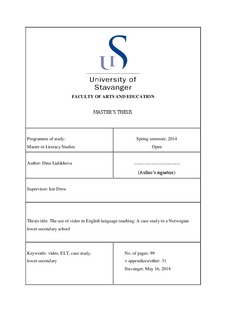| dc.description.abstract | This thesis aimed at exploring the use of video in English language teaching (ELT) in a Norwegian lower secondary school (grades 8 to 10). Videos in the thesis were represented by, for example, feature films, YouTube clips, and documentaries. The programme Språk åpner dører (Languages open doors), launched in 2007 by the Norwegian Ministry of Education and Research, included a call to learn how digital media were introduced and exploited in Norwegian classrooms. In addition, the thesis aimed to find out how videos in English lessons helped to achieve the goals of the LK06 English curriculum. The main hypothesis was that teaching with video would develop pupils’ communicative skills and, therefore, was appropriate for the communicative approach to ELT.
The study addressed five research questions regarding the use of videos in English lessons in the case study school: why the teachers used videos in ELT, what kinds of videos were used in English lessons, how and how often videos were used, what was taught and learned through the use of videos and, finally, what the teachers’ and pupils’ attitudes to lessons with videos were.
The research was performed as a case study in a Norwegian lower secondary school. The data for the research was obtained through the use of mixed methods: qualitative, in the form of interviews with four English teachers and observations of three of the interviewed teachers’ lessons with videos, and quantitative, in the form of a pupil questionnaire answered by 105 pupils from two 8th grade and two 10th grade classes.
The study showed that the lessons with video in the school were aimed at developing primarily oral and written communicative skills. Moreover, the teachers made use of videos in a meaning-based approach to ELT by providing the pupils with information on or more insight into the particular curriculum topic being taught, so that they could, for example, discuss it and produce written texts on it afterwards. The most common videos used were feature films. The teachers showed feature films in class either as a whole unit or in segments, but the most effective lessons seemed to be the ones with films shown in segments up to 35 minutes, as opposed to watching the whole film in one go.
Videos were used in general from three times a year up to every month by the different teachers.
The teachers’ practices concerning viewing activities varied: while one of the four teachers made use of pre-, while- and post-viewing activities, another used only post-viewing activities in the lessons with videos. The use of pre-viewing activities, normally without any vocabulary pre-teaching, as well as the use of English subtitles while watching, seemed likely to contribute to the pupils’ overall understanding of the video. It also seemed that the pupils’ vocabulary growth benefited to a large extent from subtitled videos, where the subtitles were in English.
Videos appeared to have a positive impact on the development of the pupils’ four language skills and vocabulary growth, as well as to scaffold the process of acquiring the pragmatic use of the language and to teach about the target language cultures. By and large, both the teachers and the pupils had positive attitudes to lessons with video.
The findings of the study suggest that teaching with video can effectively promote communicative language teaching, bring variety into ELT classrooms, motivate pupils to learn a foreign language, benefit the development of the four language skills and vocabulary growth, supplement texts in textbooks, and approach the curriculum topics via a different medium.
The thesis has contributed to the knowledge on the use of one of the digital media, namely videos, in ELT in a Norwegian lower secondary school and, to the best of the researcher’s knowledge, has contributed to a gap in the research in this field. | nb_NO |
